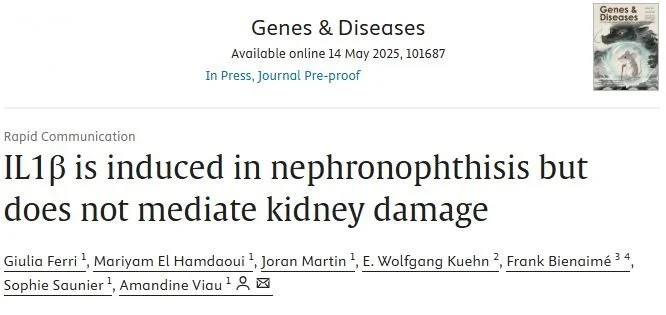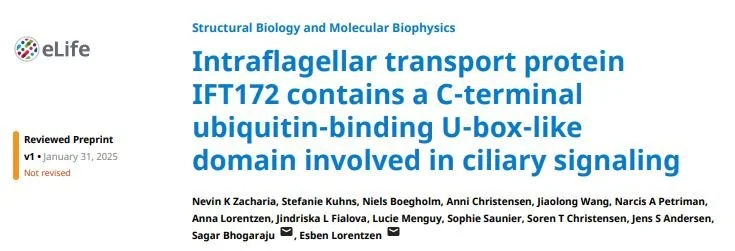
Publications
Here you can find all publications such as research articles or reviews where our ESRs are authors (with the acknowledgement of the EU funding for the SCilS-ITN grant).
Rapid Communication: IL1β in Nephronophthisis – Marker, Not Mediator
In a rapid communication our fellow Giulia Ferri (ESR11) explored the role of IL1β in nephronophthisis. The study shows that while IL1β is induced in this kidney disorder, it does not contribute directly to kidney damage. This important finding helps refine our understanding of inflammatory signaling in ciliopathies and may guide future therapeutic strategies.
KIF13B Regulates Ciliary Protein Composition and EV Shedding
Our fellow Csenge Kata Rezi (ESR7) uncovered the dynamic role of KIF13B in regulating ciliary membrane protein content and extracellular vesicle (EV) shedding in kidney epithelial cells. The research shows that KIF13B influences the timing and composition of both small and large EVs, with significant effects on ciliary protein localization and signaling. Notably, the study identifies CCDC198 and ZDHHC5 as novel ciliary proteins and potential ciliopathy candidates. These findings shed light on how KIF13B acts at the centriole distal appendages to control ciliary homeostasis and signaling, offering new perspectives on the mechanisms underlying ciliary dysfunction.
Uncovering the Dual Role of IFT172 in Ciliogenesis and Signaling
The research of Nevin Zacharia (ESR1) and Jindriska Fialova (ESR5) uncovers a dual role for the IFT172 protein—not only as a structural bridge between IFT-A and IFT-B complexes, but also as a regulator of ciliary ubiquitination and signaling pathways. By determining the crystal structure of IFT172’s C-terminal region, the team identified a conserved U-box-like domain with ubiquitin-binding and auto-ubiquitination activity. Importantly, patient variants affecting this domain were shown to impair cilium formation and alter TGFB signaling responses. This work provides a deeper understanding of IFT172-related ciliopathies and opens new avenues for exploring ciliary function and disease.
Evaluation of Prostaglandin Receptor Agonists and Eupatilin in the Context of Nephronophthisis
Exciting new findings on potential therapies for nephronophthisis! Our latest pre-print from our fellow Alice Tata (ESR11) highlights how Eupatilin and prostaglandin analogues show promise in rescuing ciliary defects and reducing cyst size, offering hope for future treatments of this ciliopathy.
Deciphering the impact of PROM1 alternative splicing on human photoreceptor development and maturation
Our fellow Marina Moya-Molina (ESR4) studied alternative splicing of Prominin-1 in retinal tissue. She used retinal organoids as her model system and showed that skipping of exon 4 of PROM-1 results in defects in cone photoreceptor cilium and abnormal accumulation of cones in the basal side of the retinal organoids accompanied with other cellular responses.
Utilization of automated cilia analysis to characterize novel INPP5E variants in patients with non-syndromic retinitis pigmentosa
Our fellow Kae Whiting (ESR2) used automated cilia analysis for percent ciliation, ciliary length, retrograde IFT trafficking and INPP5E localization. This analysis has confirmed that newly described variants of INPP5E are causative for the retinitis pigmentosa phenotypes seen in patients.
WeSA: a web server for improving analysis of affinity proteomics data
Our fellow Magdalena M. Shtetinska (ESR13) created a tool for analysis of protein-protein interactions from large proteomics datasets. This tool is available as a web server, where users can submit their own data or look for organized information on human protein interactions. Weighted SocioAffinity (WeSA) is a novel approach how to explore your interactome data and you can read more about it in this article.
ZebraReg—a novel platform for discovering regulators of cardiac regeneration using zebrafish
Our fellow Kateřina Apolínová (ESR14) established a novel platform for investigation of dynamics of cardiomyocytes regeneration in zebrafish hearts. This will allow genetic and pharmacological screenings, which will help to resolved the missing knowledge and interventions for myocardial infarction, one of the most prevalent heart diseases.
DLG1 functions upstream of SDCCAG3 and IFT20 to control targeting of polycystin-2 to the primary cilium
Our fellow Csenge Kata Rezi (ESR7) investigated a potential role of DLG1 in regulating ciliary composition in kidney epithelial cells. Her new article shows that DLG1 is a key component regulating ciliary trafficking pathway and intracellular trafficking into the primary cilium.
Rare homozygous cilia gene variants identified in consanguineous congenital heart disease patients
Daniel Baird (ESR12) explored in this study the genetic underpinnings of congenital heart disease in consanguineous populations, highlighting rare homozygous variants in cilia-related genes.
TAK1 operates at the primary cilium in non-canonical TGFB/BMP signaling to control heart development
Three of our fellows Daniel A. Baird (ESR12), Kateřina Apolínová (ESR14) and Jindřiška Leischner Fialová (ESR5) collaborated on an investigation of the role of TAK1 at the primary cilium during heart development. They found that TAK1 activation is regulated at the primary cilium during cardiomyogenesis and can by activated upon TGFB/BMP stimulation and the lack of TAK1 (caused by mutation or knock-out) leads to cardiac defects (dilated atrium, trabeculation defects, tachycardia and reduced contractility) in zebrafish mimicking syndromic congenital heart disease. You can read a preprint on BioRxiv.
Interactome Analysis Reveals a Link of the Novel ALMS1-CEP70 Complex to Centrosomal Clusters
Unraveling protein networks inside and at the base of primary cilia is a key task of our fellow Shibu Antony (ESR 3). In this new article he has contributed to the study of interactome of ALMS1, protein associated with Alström syndrome. They revealed a key interaction of ALMS1 with CEP70 for ALMS1 stabilization at the basal body. This study provides candidate lists of ALMS1 interactors that might help in deeper understanding of ALMS1 in cilia-related functions.
Fluid shear stress triggers cholesterol biosynthesis and uptake in inner medullary collecting duct cells, independently of nephrocystin-1 and nephrocystin-4
Nephronophthisis (NPH) was the focus of interest of our fellow Giulia Ferri (ESR 10). During her PhD studies she contributed to the article investigating the role of NPHP1 and NPHP4 in the mechanoresponse to the fluid shear stress in renal epithelial cells. This study revealed a mild role of these proteins in flow sensation and uncovered a novel signaling pathway induced by shear stress.
Primary cilia sense glutamine availability and respond via asparagine synthetase
Maria Elena Steidl from Alessandra Boletta’s group together with our fellow ESR (6) Anne Nielsen study how primary cilia sense available nutrients. They found out that primary cilia can adjust their length in response to nutrient availability via glutamine-mediated anaplerosis facilitated by asparagine synthetase (ASNS) localized at the base of the cilia. Ciliated cells respond to nutrient deprivation with cilia elongation and reducing glutamine-dependent mitochondrial anaplerosis which can be restored by glutamine supplementation. Their data indicate a role for cilia in responding to, and possibly sensing, cellular glutamine levels via ASNS during metabolic stress.
Generation of induced pluripotent stem cell line carrying frameshift variants in NPHP1 (UCSFi001-A-68) using CRISPR/Cas9
Our PhD fellow ESR (8) Emma Dyke has succesfully generated an induced pluripotent stem cell line carrying mutation in Nephrocystin 1 (NPHP1) gene with CRISPR/Cas9 technology. NPHP1 protein localizes to the transition zone of primary cilium and loss of NPHP1 function alters the structure of the transition zone and leads to defects in ciliary morphology, including decreased percentage of ciliation, altered ciliary length, and mislocalisation of ciliary proteins.
Biochemically validated structural model of the 15-subunit intraflagellar transport complex IFT-B
Petriman et al. together with our two fellows: ESR (1) Nevin Zacharia and ESR (13) Magdalena Georgieva has described structures of intraflagellar transport complex IFT-B. They we used Alphafold computation and designed model was validated using cross-linking/mass-spectrometry data on reconstituted IFT-B complexes, X-ray scattering in solution, diffraction from crystals as well as site-directed mutagenesis and protein-binding assays. This study bridges a gap in understanding of the IFT-B structure and allows for the mapping of ciliopathy variants in context of the IFT-B complex.
Biallelic KIF24 Variants Are Responsible for a Spectrum of Skeletal Disorders Ranging From Lethal Skeletal Ciliopathy to Severe Acromesomelic Dysplasia
Reilly et al. together with our ESR (11) Alice Tata has identified mutations in gene KIF24, which encodes a kinesin family member controlling ciliogenesis. The six affected individuals had different levels of skeletal disorders and in vitro experiments showed that primary cilia assembly was severely impaired. This study is the first report implicating KIF24 variants as the cause of a skeletal dysplasia.


















